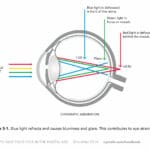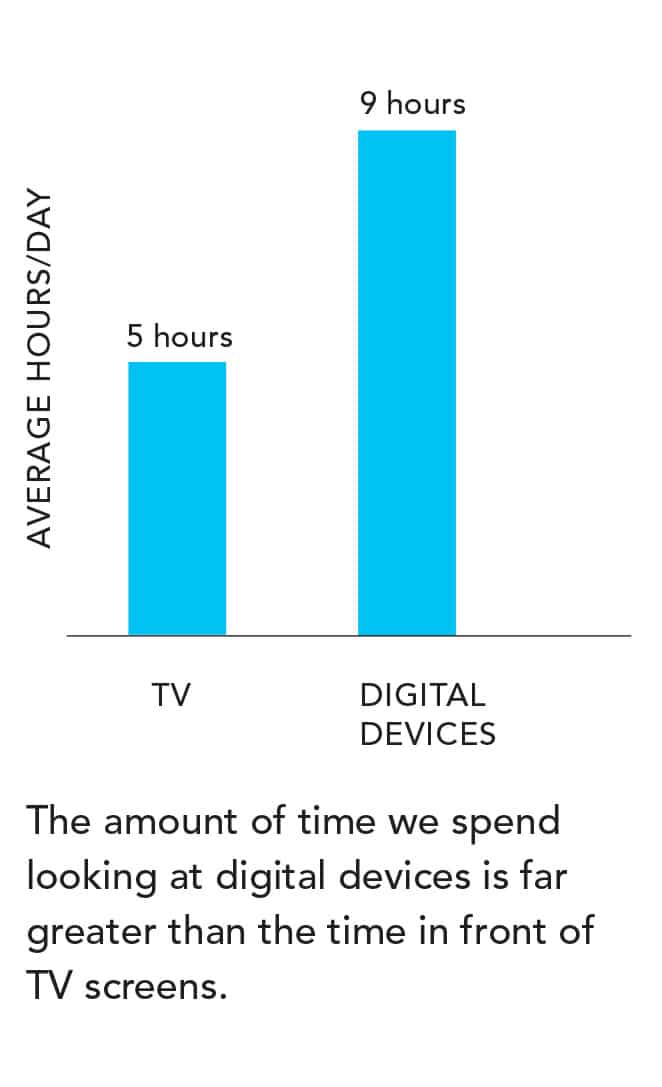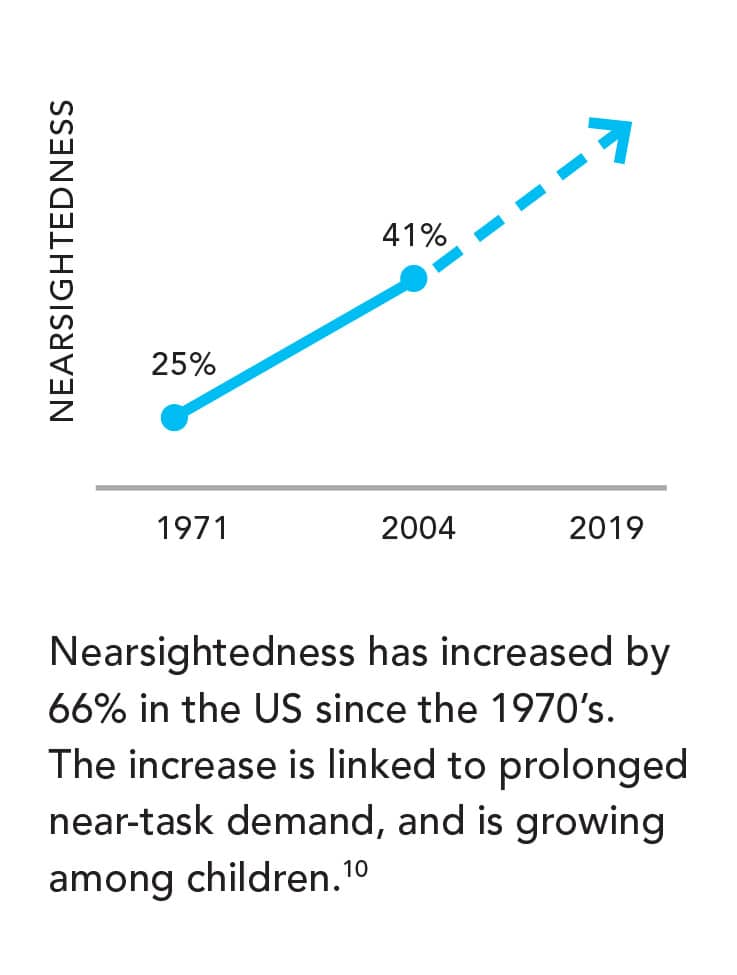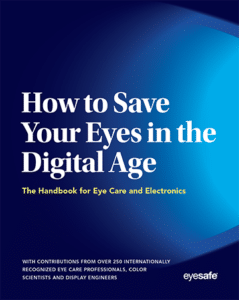How to Save Your Eyes in the Digital Age
The Handbook for Eye Care and Electronics
WITH CONTRIBUTIONS FROM OVER 250 INTERNATIONALLY RECOGNIZED EYE CARE PROFESSIONALS, COLOR SCIENTISTS AND DISPLAY ENGINEERS
SECTION 1: HOW BLUE LIGHT AFFECTS THE EYE AND BODY / CHAPTER 5
Visual Acuity and Dry Eyes
Extended periods of high energy visible (HEV) light exposure from digital displays can affect our ability to maintain clear vision, interpret images and avoid stressful symptoms including ocular fatigue and headache.
The potential toxicity of blue light from LED and OLED displays is not the only cause, but is one factor that makes our current extended daily use of smartphones, tablets, lap top computers and other digital devices a high demand task for our eyes.
Eye care providers are seeing a dramatic increase in the number of patients seeking consultation from symptoms that are related to close work with digital displays. This is generally diagnosed as digital eye strain or computer eye syndrome. Symptoms include blurred vision, dry eye and headache that can lead to reduced attention span, irritability and mood changes and an inability to perform assigned work tasks. It is estimated that digital eye strain affects over 4 billion people across the globe.1 It is the most common repetitive stress injury in the world and can be disabling. Like any contributing factor, if displays play a role in the current epidemic of digital eye strain, we should understand the underlying causes so we can better address it for the individuals impacted.
Potential Phototoxicity of Extended Blue Light Exposure
Everyone is likely to experience some visual discomfort with prolonged exposure to blue light. In the laboratory excess exposure increases the production of reactive oxidative species (ROS) and free radicals, including hydrogen peroxide and superoxides, which can be toxic to living cells.2 ROS and free radicals in the laboratory are both surface epithelial cells which can heal and retinal cells, which unlike skin cells, are not replaced by natural healing.
The retina is an outgrowth of the brain. Like all neurons, retinal cells are not capable of dividing and producing new retinal cells. Surface epithelial cell replacement helps us, for example, recover from excess ultraviolet light exposure which can cause sunburn to the skin and ultraviolet damage to the surface cells on our eyes. These surface cells can recover from toxic light exposure in about 5 days, but any retinal cells damaged cannot. Although blue light exposure from prolonged use of a digital device is less toxic than excess exposure to ultraviolet radiation, in laboratory experiments using tissue cell culture techniques, it does cause production of ROS, free radicals, cell damage and even death.3
Phototoxicity over extended periods can accelerate the aging of our eyes. There are three causes that determine severity: distance of the light source to the eye, the intensity of light, and the length of exposure.4
The eye is the only organ that allows light to deeply penetrate the body. Staring at a display that emits blue light at night or in a darkened room, which tends to dilate the pupils, can increase toxic light exposure to the retina.
Accommodation
Accommodation is the umbrella term for how our eyes adjust from distance to near tasks.5 Our brains seek clear images to interpret, and without adequate accommodation near images are blurry. The natural reduction in accommodation that occurs with age leads to a condition called presbyopia. Once one develops presbyopia, reading glasses or progressive lenses are required for good near vision. Our eyes must also turn in or converge to see a near image clearly. This is achieved by coordinated activity of the eye muscles inside and outside the eye. Accommodation and convergence need to work together to achieve clear single vision at near distance with no blurring. This is a complex muscle driven task, and excess near vision demand can also lead to eye strain. The pupils inside our eyes also dilate or contract in response to changes in light intensity and accommodation. If objects are not perfectly clear, we may squint or blink frequently, consciously or not, to achieve momentary clarity.
Our eyes continuously make minute adjustments in response to the ever changing images and visual demands they encounter. Any set of muscles tires with constant use in demanding conditions. All this focusing and refocusing can be demanding over extended periods of time and lead to ocular fatigue symptoms including digital eye strain.
A lag of accommodation and convergence is being recognized as one reason why cell phone use while driving is the #1 cause of traffic accidents.8 Blurred distance vision and difficulty refocusing is also linked to dry eyes, which can also be caused by blue light exposure and reduced blink rate that can accompany excess exposure to digital devices.
Glare and Blurry Vision
Light entering the eye refracts according to wavelength, with blue light converging ahead of the green and red portions (see Figure 5-1). This is called chromatic aberration. Shorter and longer wavelengths are more out of focus when they reach the back of the eye and illuminate the retina. Blue light creates a blur circle or haze in the light detecting portions of the eye. Blue light also scatters more in the eye and increases the effort it takes to maintain focus. Excess blue light reduces contrast and causes glare. We can adjust some through pupil constriction and squinting. In a glare environment, the speed at which we can interpret images goes down. Eye care providers often prescribe so-called blue blocking eye glasses to reduce glare and enhance contrast sensitivity.
The sensation of glare, with halos, haze and blurriness, is a frequent complaint of eye patients working with digital displays.
Dry Eye Disease
The near universal use of digital devices and growing continuous duration of usage has been highlighted in numerous studies. Among computer users, almost 50% show symptoms of dry eye disease.1
When staring at a screen, our blink rate goes down from a normal rate of 20 per second to 10 or less.5 When using a digital device, we blink at half the rate compared to reading a book. Slower blink rate is linked to high cognitive demand. Slower blinking can speed the evaporation of the tear film that lubricates and protects the surface of the eye. Excessive High Energy Blue Light exposure is negatively linked to tear film stability. When dryness occurs, our eyes have to work even harder to try to present a clear image to the retina and brain.6
Although blue light from displays causes glare, and is linked to digital eye strain, the impact is usually transient and there are few studies that demonstrate a long term impact. The amount of time we spend looking at digital devices is far greater than the time in front of TV screens. In addition, studies show that people on average are sleeping less than previous generations, giving their eyes less rest. People on average spend an enormous amount of time in front of digital device displays, and less time outside. One study found that people reach for their phones in the morning, more often ahead of coffee, a toothbrush or their significant other.5
Nearsightedness (Myopia)
Nearsightedness has increased by 66 percent since the 1970s, according to The National Eye Institute.10 About 42 percent of Americans ages 12-54 are nearsighted. Increased myopia has many contributing factors, and prolonged near-task demand, with hours of accommodation, along with excess exposure to blue light from displays are all implicated.
Clearly, the worldwide increase in myopia is an alarming trend with real social costs. Surveys in multiple countries point to a growing incidence in children. A child’s continued effort to maintain near focus can stress and lead to an elongation the eye, resulting in progressive and permanent myopia or nearsightedness.
According to researchers, rates of myopia have doubled, even tripled, in many eastern Asia countries during the past 40 years. Hong Kong, Singapore, China and Taiwan have experienced rate increases for myopia approaching 90 percent in their children.
Social Costs of Decreasing Visual Acuity
Too much screen time on digital devices like smartphones, tablets and computers may potentially increase the risk of children developing progressive myopia. The good news is that increased time spent outdoors or in environments that relax accommodation may help slow its progression.
Approximately 33 percent of the world’s working population has uncorrected vision problems that result in a $272 billion loss of productivity to businesses globally.11 Adults with varying levels of visual acuity require more muscular effort to maintain clear near focus over a long period. Vision correction, with eyeglasses or contacts, is frequently needed. In older populations there is a growing incidence of presbyopia, dry eye, cataract, age-related macular degeneration, and retinal disease (retinopathy). The direct costs worldwide of vision loss in 2012 were $2.3 trillion. Any measure that can reduce the personal and economic burden of vision loss is worthy of serious consideration. Excess blue light exposure from increasing digital device use, which contributes to our current epidemic of digital eye strain, is deserving of more attention and preventive measures.
Richard Lindstrom, MD is the founder and attending surgeon at Minnesota Eye Consultants, Adjunct Clinic Professor Emeritus at the University of Minnesota Department of Ophthalmology, and visiting professor at the UC Irvine Gavin Herbert Eye Institute. He has been at the forefront of ophthalmology’s evolutionary changes throughout his career.
Paul M Karpecki, OD Fellow of the American Academy of Optometry, is Medical Director, Total Eye Care Partners, Director of Cornea, Kentucky Eye Institute & Gaddie Eye, Associate Professor, Kentucky College of Optometry, and Chief Medical Editor, Review of Optometry, the most read journal in the profession.
CHAPTER IMAGE GALLERY
There are three causes that determine severity:
1. Distance of the light source
2. Intensity of light
3. Length of exposure4

• Focus
• Muscular coordination
• Squinting
• Convergence
• Dilation
• Blinking
References
- Digital eye strain: prevalence, measurement and amelioration, by AL Sheppard, JS Wolffsohn, BMJ Open Ophthalmology, 2018.
- Blue Light phototoxicity toward human corneal and conjunctival epithelial cells in basal and hyperosmolar conditions, by V Marek et al., Free Radical Biology and Medicine, 2018.
- Photochemical Damage of the Retina, by Jiangmei Wu, Stefan Seregard, and Peep V. Algvere, Survey of Ophthalmology Vol. 51(5), Sep-Oct 2006.
- 20/20 blue light refocused – separating science from speculation, by Gary Morgan, OD, Jobson Medical Information LLC.
- Computer vision syndrome (a.k.a. digital eye strain), by Mark Rosenfield, MCOptom PhD FAAO, Optometry in Practice 2016, Volume 17, Issue 1.
- Management of digital eye strain, by Chantal Coles-Brennan OD FAAO, et al, Clinical and Experimental Optometry 102.1 January 2019.
- Blue light: from scientific evidence to patient care, by Victor Javier Garcia Molina, Points de Vue – International Review of Ophthalmic Optics 3, www.pointsdevue.com Special Edition – Collection of articles from 2011 to 2017.
- Seeing Blue: The impact of Excessive Blue Light Exposure, by Heather Flint Ford, OD, Review of Optometry, April 15, 2016.
- Will “digital vision” mean a blurry future? by Maureen Cavanagh, PDV N°72 Autumn 2015 [Market Watch], Points de Vue – International Review of Ophthalmic Optics 3, www.pointsdevue.com Special Edition – Collection of articles from 2011 to 2017.
- Myopia – National Eye Institute – NIH.
- Global Prevalence of Myopia and High Myopia and Temporal Trends from 2000 through 2050, by B.A. Holden, T.R. Fricke, D.A. Wilson, M. Jong, et al., Ophthalmology, 2016.
Get the EBook:
Download the digital edition of HOW TO SAVE YOUR EYES IN THE DIGITAL AGE: The Handbook for Eye Care and Electronics, and learn more.










